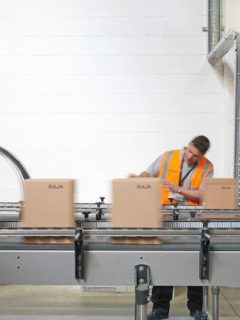Society, and with it consumers, are becoming increasingly sensitive to the environment. A recent IPSOS and Sopra Steria survey even showed that environmental protection had moved to the #1 position among French people’s concerns, ahead of the future of the social system and difficulties in purchasing power. No wonder, then, that e-tailers are becoming increasingly interested in this area themselves.Packaging that does not respect the environment can have an effect on a website’s conversion rates, with consumers inclined to leave unfavourable reviews of brands that are not very concerned with the planet
Watch the RAJA webinar (35 min)
so whether or not you’re a firm believer in this eco-responsible approach, you need to address your eco-responsible packaging. It’s not as complex as it sounds! Here are the first 3 keys to consider in moving towards a truly responsible e-commerce.
- Key #1: Targeting the perfect customer experience
- Key #2 : Opt for eco-responsible packaging materials
- Key #3 : Reduce the impact of your e-commerce transport
clé #1 : Cibler une expérience client parfaite
On sait déjà depuis longtemps que l’expérience client est essentielle dans la logistique e-commerce. Une étude Package Insight a d’ailleurs déjà prouvé que 73% des clients qui reçoivent une marchandise endommagée ne reviendront pas.
Toutefois, l’expérience client, au-delà de l’effet “waouh” à l’unboxing, a également une influence sur la perception éco-responsable de votre marque.
En effet, en visant une expérience client parfaite, vous faites en sorte d’éviter la logistique retour, avec un client insatisfait qui vous renvoie le colis. Vous économisez ainsi un impact environnemental lié au transport, mais aussi bien souvent à la destruction de la marchandise, qui est souvent mise au rebut faute de circuits secondaires bien identifiés.
De plus, si un produit est cassé pendant la livraison, vous faites face à un triple coût : le coût environnemental (le produit est jeté, et pas toujours recyclé), le coût du transpor
-
Choose packaging that is easy to return
-
Select packaging that is easy to sort and dispose of, with respect for the planet
-
Avoid breakage as much as possible, with a breakage rate close to zero

Key #2: Opt for eco-responsible packaging materials
Choosing eco-responsible packaging for your e-commerce business means, of course, choosing more virtuous materials: recycled, recyclable, biodegradable, compostable… But sometimes, the task can seem complex. Here is our method in 2 key steps to achieve this without jeopardising your current processes
-
Step 1: Keep the same type of packaging as at present, but look for packaging that is more easily recyclable or contains recyclable materials. Adapting to the new packaging is easy for your operators.
-
Step 2: Find a packaging that is totally eco-responsible (easily recycled, or even biodegradable or compostable) and/or made from recycled materials. You may need to resize your packaging as well, to save raw material. This step may require training your pickers, and therefore may require a little more effort.
in short, go step by step towards eco-responsible packaging materials!
You should know that each type of material has its own ecological alternative. Here are some examples, following our 2-step method
| Packaging | Step 1 alternatives | Alternatives step 2 |
| Kraft box and crate | Recycled cardboard | |
| Opaque plastic pouch | Recycled plastic opaque pouch | Kraft pouch |
| Bubble pouch | Mixed bubble pouch with recycled material | – 100% paper padded pouch – Microflute cardboard pouch |
This eco-responsible packaging offers the same performance (in terms of resistance, protection) as conventional packaging. But also think about eco-responsible cushioning solutions
| Packaging | Alternatives step 1 | Alternatives stage 2 |
| Polystyrene | Kraft cardboard cushioning | Paper or recycled plastic cushioning |
| Foam | Kraft cardboard cushioning | Paper or recycled plastic cushioning |
| Dunnage particles (dunnage chips) | Biodegradable cushioning particles (starch) | |
| Plastic cushioning | Paper or recycled plastic cushioning | |
| Kraft cushioning | Paper or recycled plastic cushioning |
RAJA’s extra tip: Also think about the eco-responsible alternative for your adhesive: kraft paper adhesive. 100% recyclable, made of kraft and natural rubber glue, it goes into the yellow bin at the same time as your recyclable packaging. It has the same adhesive power as standard adhesive, and is very operational. This is an easy first step to take, with an immediate impact on your customer’s perception of the parcel! You can even personalise it with your brand’s colours. Whatever your choice, when you change your packaging, be sure to do it in 2 key phases
Whatever your choice, when you change your packaging, be sure to do it in 2 key phases
-
Start by testing the mailing to internal addresses. As the Post Office and the Couriers do not have the same handling, test these mailings on all your carriers.
-
Then send to real customers, targeting medium-sized order categories first, to test on small quantities.
in short, as with your e-commerce site, switch to eco-responsible packaging in test-and-learn mode.
Key #3: Reduce the impact of your e-commerce transport
- Expand your range of packaging, to reduce the void, cushioning, and therefore the cost of transport when you are billing by volume weight.
- Use variable height boxes, which allow you to adapt the packaging to the products it contains.
-
Apply the ColisConsult x RAJA method: a systematic methodology that allows you to find the intermediate sizes of packaging that you really need, and thus optimise the weight volume of your parcels.

L’astuce RAJA en plus: Vos colis pourraient-ils passer en boîte aux lettres ? Cela peut être le cas, grâce à un emballage éco-responsable personnalisé, qui vous permet d’éviter une seconde tournée (et donc de réduire votre impact environnemental). Pour ce faire, il vous faut concevoir votre emballage de sorte à ce qu’il rentre dans la fente de 3cm d’une boîte aux lettres typique.
C’est ce qu’a fait l’entreprise Cheerz : consultez le cas de ce site e-commerce novateur en termes d’emballages ici.
Le cas concret inspirant d’un e-commerçant
Pour vous donner envie d’aller vers une logistique e-commerce et des emballages éco-responsables, découvrez le cas d’un e-commerçant, leader du secteur du mobilier et de la décoration.

En quelques semaines, avec une forte implication, l’entreprise a retravaillé l’ensemble de sa démarche pour réduire son empreinte carbone
| BEFORE | AFTER |
Cushioning solutions
|
Cushioning solutions
|
Problems identified
Average packing time: 55 seconds |
Improvements observed
Average packing time: 35 seconds |
Packaging
|
Packaging
|
Problems identified
|
Improvements observed
|
Et en termes de coûts, qu’est-ce que ça donne ?
Adopter une démarche et des emballages éco-responsables peut paraître devoir demander un budget plus conséquent. Mais l’addition n’est pas si simple à faire.
Si l’on observe le prix de l’emballage éco-responsable, il paraîtra souvent plus cher (15 à 20% en moyenne). Cependant, les économies générées, plus difficiles à observer, en termes de retour de marchandises ou d’expérience client, viennent bien souvent compenser ce budget initial plus élevé.
De plus, plus votre volume d’expédition est conséquent, plus le coût de vos emballages
-
Putting a leaflet in your parcel to explain your approach
-
Talking about your green initiatives on your website and social networks
-
Communicating directly on the packaging: FSC logo (from well-managed forests) or % of recycled material in the packaging..
storytelling your environmental commitment: your customers will repay you with loyalty and satisfaction















